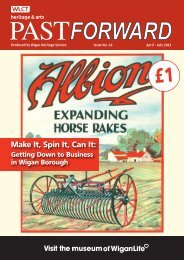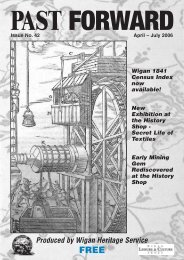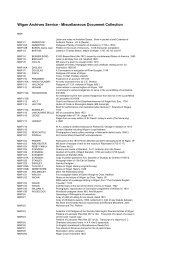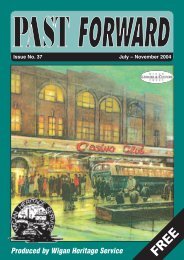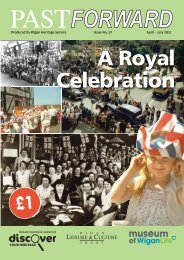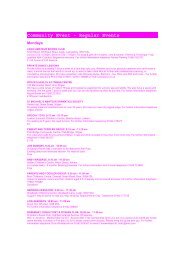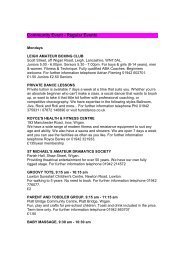Wigan Pier to Leigh Bridge
Wigan Pier to Leigh Bridge
Wigan Pier to Leigh Bridge
You also want an ePaper? Increase the reach of your titles
YUMPU automatically turns print PDFs into web optimized ePapers that Google loves.
Penning<strong>to</strong>n Flash<br />
Mansley’s Rope Works<br />
⑩ Mansleys has been replaced by a new<br />
wharf-side pub and offices. Mansleys<br />
manufactured fine rope whilst also retailing<br />
locally brewed beer! It burned down in<br />
1912.<br />
<strong>Leigh</strong><br />
The name <strong>Leigh</strong> means meadow, and<br />
reveals the <strong>to</strong>wn’s rural origins. Up and<br />
until the late 1800s, <strong>Leigh</strong> was noted for its<br />
dairy produce, especially local cheeses (one<br />
of which was called the <strong>Leigh</strong> Toastie).<br />
Industrialisation in the 18th and 19th<br />
centuries brought growth boosted by the<br />
new canal links. <strong>Leigh</strong> is the birth place of<br />
Thomas Highs (1720), who was thought <strong>to</strong><br />
have invented the Spinning Jenny only <strong>to</strong><br />
have the patent taken from him by James<br />
Hargreaves in 1770.<br />
This walk forms part of a series of walks and trails<br />
developed by Manchester's Countryside.<br />
All walks can be viewed and downloaded at:<br />
www.manchesterscountryside.com<br />
<strong>Wigan</strong> Tourist<br />
Information Centre.<br />
01942 825677<br />
www.visitwigan.com<br />
For more information on Manchester's<br />
Countryside telephone: 01942 825677<br />
info@manchesterscountryside.com<br />
Introducing<br />
Manchester’s<br />
Countryside<br />
<strong>Wigan</strong> <strong>Pier</strong> <strong>to</strong><br />
<strong>Leigh</strong> <strong>Bridge</strong><br />
<strong>Wigan</strong> <strong>Pier</strong> – Westwood Park – <strong>Wigan</strong><br />
Flashes – Bamfurlong – Dover Lock –<br />
Penning<strong>to</strong>n Flash – <strong>Leigh</strong> <strong>Bridge</strong><br />
Walk 4
<strong>Wigan</strong> <strong>Pier</strong> <strong>to</strong><br />
<strong>Leigh</strong> <strong>Bridge</strong><br />
Distance:<br />
7 3/4 miles/12.5km.<br />
Walk summary:<br />
Starting at the iconic <strong>Wigan</strong> <strong>Pier</strong> and taking<br />
you through the unique collection of lakes<br />
and waterways known as <strong>Wigan</strong> Flashes<br />
and on through the Hey Brook Corridor <strong>to</strong><br />
delightful Penning<strong>to</strong>n. A canal-side trail rich<br />
in natural his<strong>to</strong>ry and heritage.<br />
How <strong>to</strong> get there:<br />
This trail has a railway station<br />
near its start. Regular busses<br />
connect <strong>Wigan</strong> and <strong>Leigh</strong>. To get<br />
information on public transport<br />
contact:<br />
Greater Manchester<br />
Public Transport Information<br />
0161 228 7811<br />
www.gmpte.com<br />
A49 Wallgate<br />
<strong>Wigan</strong><br />
Town<br />
Centre<br />
The Walk<br />
<strong>Wigan</strong> <strong>Pier</strong><br />
① Begin your walk at the famous <strong>Wigan</strong><br />
<strong>Pier</strong> that got its name from the canal side<br />
coal tippler which you will see opposite the<br />
main warehouse building. <strong>Wigan</strong> <strong>Pier</strong> was<br />
made famous by the two Georges. George<br />
Formby Snr who used the name as part of a<br />
Vic<strong>to</strong>rian music hall joke; and by George<br />
Orwell who in 1936 wrote The Road <strong>to</strong><br />
<strong>Wigan</strong> <strong>Pier</strong>.<br />
Head south on the Leeds-Liverpool Canal.<br />
Walk alongside the impressive Trencherfield<br />
Mill (1907). Follow the <strong>to</strong>wpath underneath<br />
the road bridge. The canal splits a few<br />
minutes later. Take a right, crossing the<br />
footbridge on<strong>to</strong> the <strong>Leigh</strong> Branch.<br />
Westwood Power Station (c.1940)<br />
①<br />
Westwood Power Station<br />
② Look over the canal at the new office<br />
blocks. It was here that <strong>Wigan</strong> Corporation<br />
Electricity Department managed <strong>Wigan</strong><br />
Power Station. Westwood used 2000 <strong>to</strong>nnes<br />
of coal per week and provided 120,000<br />
kilowatts of electricity for local consumption.<br />
The last use of the canal for commercial<br />
traffic was by the short boat ‘Roland’<br />
taking coal <strong>to</strong> this site in August<br />
1972. ‘Roland’ can now be seen in<br />
the car park at Trencherfield Mill.<br />
Scotmans and Pearsons Flashes<br />
③ A Flash is a unique industrial<br />
legacy <strong>to</strong> <strong>Wigan</strong>. There are many in<br />
and around <strong>Wigan</strong> (particularly Scotmans Flash<br />
present on this walk). Each are lakes<br />
formed as a result of mining subsidence.<br />
Here the canal splits two flashes.<br />
②<br />
③<br />
④<br />
Walk 4<br />
Ince Moss<br />
Both are<br />
designated Sites<br />
of Special Scientific<br />
Interest. This is due <strong>to</strong> the<br />
abundance of rare plant<br />
species, several species of<br />
orchid, extensive reed beds<br />
and migrating birds such as<br />
Reed and Sedge Warbler.<br />
Scotmans (on the right) is the largest of the<br />
‘<strong>Wigan</strong> Flashes’ although Penning<strong>to</strong>n Flash<br />
near <strong>Leigh</strong> is the largest in the borough.<br />
Pearsons Flash is the lake on the opposite<br />
side of the canal. Pearsons provided the<br />
water for the cooling <strong>to</strong>wers at Westwood.<br />
As you reach the end of Scotmans Flash<br />
take the footbridge across the canal.<br />
(Alternatively you may decide <strong>to</strong> stay on<br />
this side of the canal and take one of the<br />
trails that cut through Scotmans or run<br />
alongside the canal eventually accessing<br />
Lightshaw, Land Gate and Three Sisters<br />
Recreation Areas).<br />
⑤<br />
Lightshaw Hall Flash.<br />
④ Five minutes later, the <strong>to</strong>wpath bends<br />
left. On the far side is Lightshaw Hall Flash.<br />
One of the many small flashes along this<br />
stretch of the canal and another important<br />
area for birds, especially wildfowl and<br />
waders.<br />
Land Gate, Three Sisters and<br />
Bryn Hall<br />
⑤ Access <strong>to</strong> these areas is by a series<br />
of worn paths on the far side of the<br />
canal. (Vehicle access is from the A49<br />
following signs for Three Sisters).<br />
There are ponds, lakes, woodland<br />
walks, cycling trails and bridleways.<br />
At the centre is Three Sisters<br />
Recreation Area. Three Sisters takes its<br />
name from three hills which were formed<br />
from coal slag heaps.<br />
At Three Sisters you<br />
will find a small lake<br />
and Ranger Station.<br />
Here you can follow<br />
miles of way marked<br />
routes, some of<br />
which skirt the Land Gate<br />
Three Sisters Racing<br />
Circuit – an internationally accredited mo<strong>to</strong>r<br />
racing circuit.<br />
Bamfurlong<br />
<strong>Bridge</strong><br />
A58<br />
⑥<br />
Dover Lock Inn<br />
⑦<br />
Dover Lock<br />
⑥ At Bamfurlong Road <strong>Bridge</strong>, cross<br />
over <strong>to</strong> the other side of the canal. Three<br />
quarters of a mile on and you will come<br />
across The Dover Lock Inn. It was here in<br />
1820 that the <strong>Leigh</strong> Branch opened,<br />
connecting it <strong>to</strong> the <strong>Bridge</strong>water Canal.<br />
Dover and the nearby <strong>to</strong>wnship of Abram<br />
were at the centre of <strong>Wigan</strong>’s coal industry.<br />
The Maypole Pit in Abram was the site of<br />
the Borough's biggest colliery disaster when<br />
in 1908, 75 miners lost their lives.<br />
Bickershaw Colliery Site<br />
⑦ Moving further down the <strong>to</strong>wpath<br />
(1 1/2 miles past Dover Lock Inn) you will<br />
see, across the canal the Bickershaw Colliery<br />
Site. The site has an obvious mining<br />
tradition going back some 155 years. This<br />
was one of the largest mines in Lancashire<br />
with over 7 miles<br />
of pit shaft. In its<br />
heyday the pit<br />
employed over<br />
1500 miners and<br />
produced 600,000<br />
<strong>to</strong>nnes of coal per<br />
year. Bickershaw<br />
was <strong>Wigan</strong>’s last pit, closing on the 27th<br />
March 1992. It has <strong>to</strong>day been transformed<br />
in<strong>to</strong> a vast expanse of beautiful woodland,<br />
green field and nature reserve.<br />
Penning<strong>to</strong>n Flash<br />
⑧ Look right and you will see the largest of<br />
the Flashes. Penning<strong>to</strong>n Flash is one of the<br />
north west’s premier sites for bird<br />
watching, with over 230 species of bird<br />
recorded including Marsh Harrier, Spoon<br />
Bill, Leachs Petrel and the very rare Siberian<br />
Black Faced Bunting. You can drop down<br />
from the canal in<strong>to</strong> the park with its 70<br />
hectare lake, bridle paths, picnic areas and<br />
even a 9-hole golf course.<br />
⑧<br />
A579<br />
<strong>Leigh</strong> Town Centre<br />
A580<br />
A572<br />
⑨⑩<br />
Bickershaw Colliery<br />
Waterside<br />
Inn<br />
Welch Hill Mill<br />
⑨ As you leave Penning<strong>to</strong>n, you<br />
quickly enter the built up <strong>to</strong>wn of<br />
<strong>Leigh</strong>. Welsh Mill sat just beyond the first<br />
road bridge that you pass under. The<br />
mill, built in 1893 was home <strong>to</strong><br />
Gamble and Smith, manufacturers of<br />
fine cot<strong>to</strong>n.



